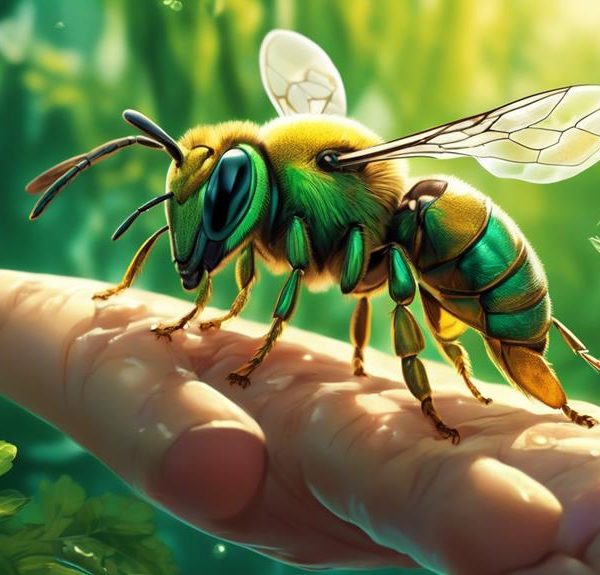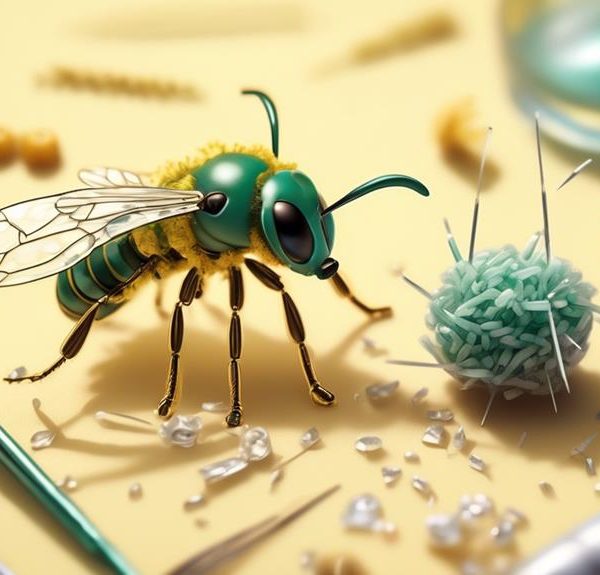Delve into the unexplored potential of sweat bee stings triggering severe allergic reactions like anaphylaxis in this compelling read.

Can Sweat Bees Cause Anaphylaxis
Is it possible that the sting of the tiny sweat bee could trigger an anaphylactic reaction?
You've likely encountered these minuscule insects in your garden, drawn to the salty sweat on your skin, and you've perhaps even experienced their bite.
While they're generally considered harmless, there's a theory that their sting could potentially result in severe allergies such as anaphylaxis in highly sensitive individuals.
This is a topic that's not been explored in depth in the public domain, and its implications could be significant for those who are vulnerable.
So, let's take a moment to unpack this, shall we?
Key Takeaways
- Sweat bees are attracted to human sweat due to its salt, moisture, and amino acids.
- Sweat bee stings are usually less painful than other bee stings and may cause a mild burning sensation.
- Anaphylaxis is a severe allergic reaction that can be triggered by sweat bee venom in individuals with an allergy to the venom.
- Immediate medical attention is necessary for those who experience symptoms of anaphylaxis after a sweat bee sting.
Understanding Sweat Bees
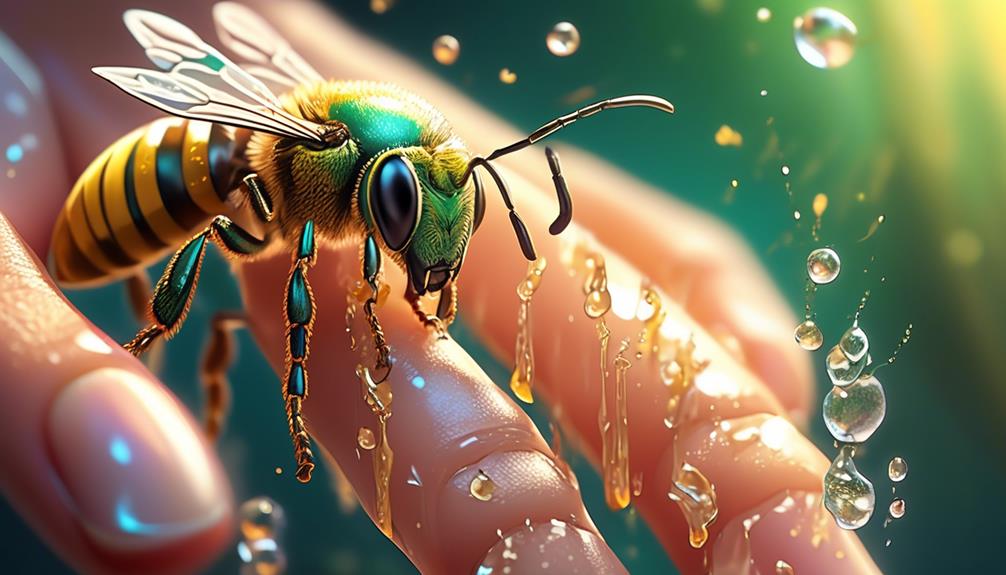
Let's dive right into understanding sweat bees, tiny insects that are named for their attraction to human sweat. You mightn't realize it, but these little creatures are more common than you think. They're part of the Halictidae family, a large group with over 3500 species worldwide.
Now, don't be too alarmed. Although they're attracted to your sweat, they're not typically aggressive. However, they'll sting if they feel threatened. You'd likely need to accidentally squish one or disturb their nest for that to happen. Their sting, though, isn't as painful as you might expect. It's usually compared to a pinprick, a minor discomfort rather than excruciating pain.
But here's where it gets interesting. Sweat bees don't just like your sweat for its salt. They're also attracted to the moisture and amino acids it provides. Isn't that fascinating? Such small creatures, yet so complex in their needs and behaviors.
The Sting of Sweat Bees

While you now know that sweat bees aren't generally aggressive, you're probably curious about what happens when they do sting. Let's dive into that.
When a sweat bee stings, it's usually because it feels threatened. Unlike honeybees, which can only sting once, sweat bees can sting multiple times. However, their stings are less painful than those of other bees. You'll likely feel a slight prick, followed by a mild burning sensation. The severity of the sting can vary based on your body's reaction, but it's typically less intense than a mosquito bite.
The area of the sting might turn red, swell slightly, and itch. It's important not to scratch it, as this can lead to infection. Instead, clean the area with soap and water, and apply a cold compress to reduce swelling. Over-the-counter pain relievers can help with discomfort.
However, like all bee stings, there's a small chance you could have an allergic reaction. If you experience symptoms like difficulty breathing, hives, or swelling of the face and throat, you should seek medical attention immediately. Remember, sweat bees aren't out to harm you, but it's crucial to be aware of the risks.
Anaphylaxis: A Severe Allergic Reaction

If you're stung by a sweat bee and your body kicks into overdrive, you might be experiencing anaphylaxis, a severe and potentially life-threatening allergic reaction. Don't underestimate this. It's not just a bad reaction; it's a medical emergency that demands immediate attention.
You might ask, what triggers anaphylaxis? Well, it's your body's extreme response to an allergen. In this case, the sweat bee's venom. Your immune system, in a misguided attempt to protect you, releases a flood of chemicals that cause a cascade of symptoms. These can include:
- Difficulty breathing due to swelling in your throat
- A rapid, weak pulse
- Skin reactions like hives or itching
- Dizziness or fainting due to a sudden drop in blood pressure
If you notice these symptoms, don't wait. Anaphylaxis can progress rapidly and without immediate treatment, it could be fatal. Your best bet is to get yourself to a hospital as soon as possible. Remember, it's always better to be safe than sorry when it comes to anaphylaxis.
Sweat Bees and Anaphylaxis: The Connection
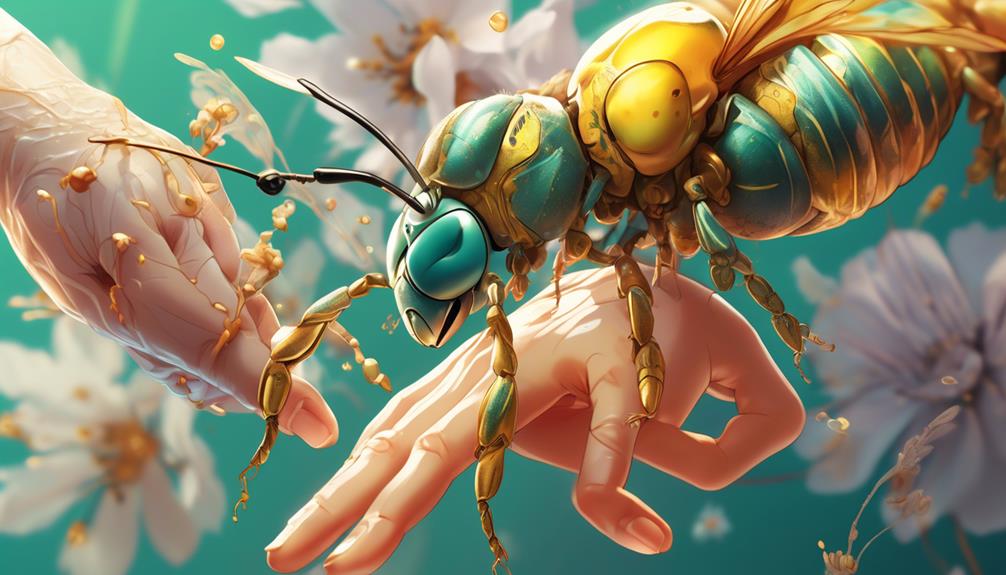
Often, you may not realize the connection between sweat bees and anaphylaxis, but it's the bee's venom that can trigger this severe allergic reaction in some people. When a sweat bee stings, it injects venom into your skin. For most, this simply results in pain and swelling, but for those with an allergy to sweat bee venom, the consequences can be more severe.
Anaphylaxis is a rapid, full-body allergic reaction that can be life-threatening. It's not the sting itself causing this reaction, it's your body's response to the venom. Your immune system overreacts, releasing chemicals that flood your body. This can lead to anaphylactic shock, causing a drop in blood pressure and narrowing your airways.
It's important to note that not everyone who gets stung by a sweat bee will experience anaphylaxis. It's fairly rare, but for those who are allergic, it's a serious risk. Immediate medical attention is necessary if you experience symptoms such as difficulty breathing, rapid heartbeat, dizziness, or hives following a sting.
Prevention and Treatment Options
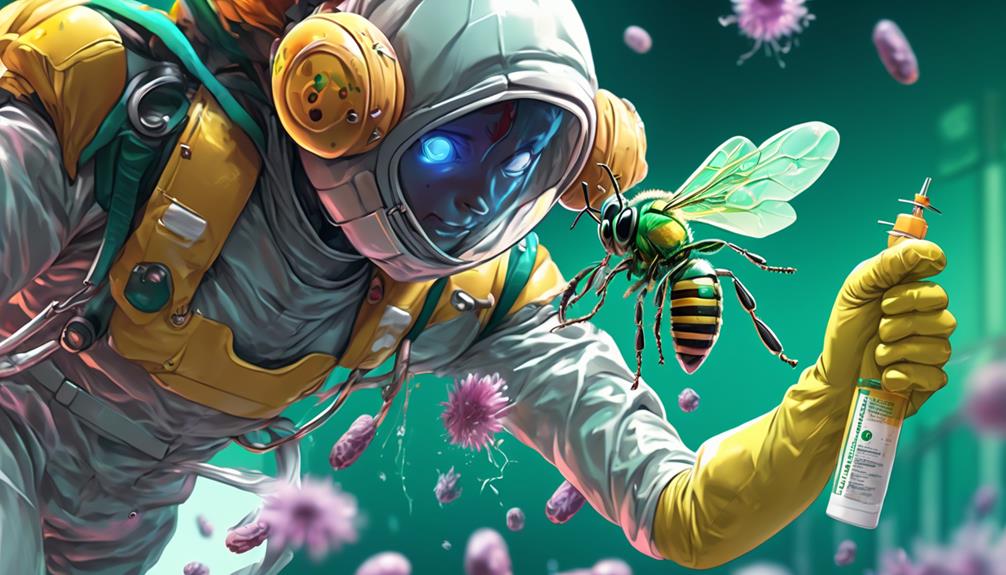
To protect yourself from sweat bee stings and potential anaphylaxis, it's crucial to understand the prevention methods and treatment options available.
The first step is prevention. You can deter sweat bees by avoiding strong fragrances, such as perfumes and scented soaps. Also, wearing light-colored clothing can help since these bees are attracted to dark colors. It's also essential to keep your surroundings clean, particularly of food and sugary drinks that can attract these bees.
If you're stung by a sweat bee, immediate treatment is necessary. Here are some steps you can take:
- Remove the stinger without squeezing it, as this can release more venom.
- Wash the area with soap and water to prevent infection.
- Apply a cold pack to reduce swelling and pain.
- Seek medical attention if you experience symptoms of an allergic reaction, such as difficulty breathing or swelling in the throat.
Conclusion
So, can sweat bees cause anaphylaxis? Yes, they can. But it's rare, and usually only if you're allergic to their venom.
Remember, these little guys aren't out to get you. They're more interested in your sweat than causing harm.
Still, if you're stung and symptoms of anaphylaxis occur, seek medical attention immediately. Prevention, like avoiding areas where they're common, is key.
And remember, treatment options are available if you're stung.

